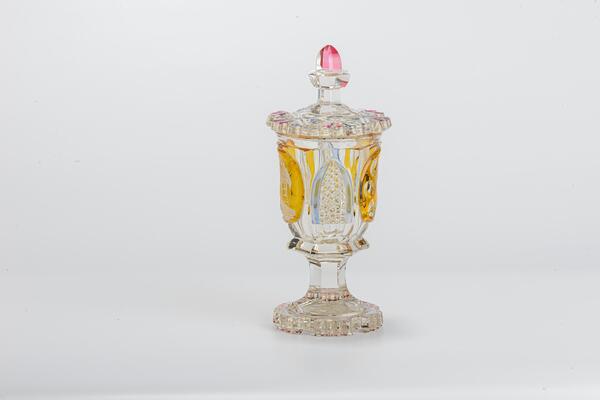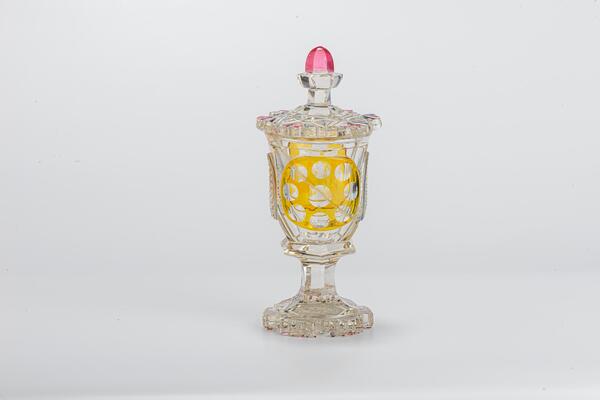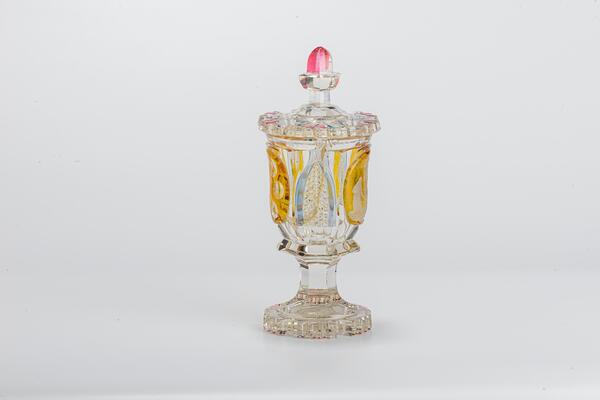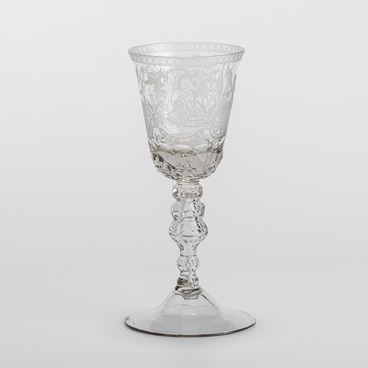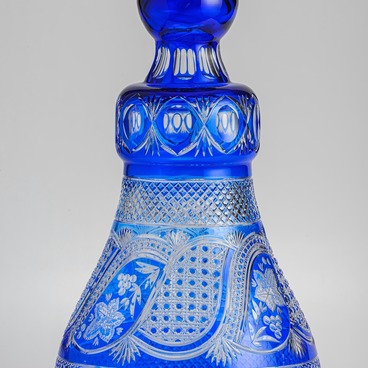Until the revolution of 1917, the Nikolsko-Bakhmetevsky plant produced a large number of liturgical objects and church items. In 1813, in the village of Nikolskoye, the thirty-year construction of a stone church of the Resurrection of Christ, with two bell towers and chapels, was completed. The landowners Bakhmetevs took joy in decorating the building and making it look more beautiful. Among other things, they generously donated glassware to the church.
Glass altar lamps, chandeliers, diskos dishes, crosses, ciboria, floor candlesticks, and Easter eggs completed the decor of the church, and the altar rail consisted of milk glass balusters. According to the memoirs of Nikolskoye villagers, even the floors in the temple were lined with white and blue glass tiles. During the Christmas and Easter weeks, glass balls with amalgam were put on the balusters of the altar rail.
Many religious items are kept in the Museum of Glass and Crystal. The presented chalice is one of them. This impressive thick-walled glass goblet with large carvings and a massive lid is intended strictly for the communion ritual. The purpose of the object is indicated by the gospel scene of the descent from the cross. The matte image is engraved and placed in one of the medallions.
There are two medallions with silver etching. The second medallion is decorated with nine large grooves. The bell-shaped body rests on a massive low leg. The base of the leg is made in the form of six toothed petals.
There are relief arches between the medallions, and there is a relief leaf in the middle. It was processed with blunt and sharp hexagons, and the edges were covered with blue luster paint. The petals on the base and the lid were also painted with luster: pink, blue and purple.
The technique of silver etching was used to decorate the goblet. Medieval artists referred to it as “silver yellow”: they used it to decorate the windows of churches and cathedrals since the 11th century. It was also mentioned in Kunckel’s book “Ars Vitraria” (the 18th century).
The presented chalice could be intended not only for the local parish, but also for the decoration of churches in other governorates.
Glass altar lamps, chandeliers, diskos dishes, crosses, ciboria, floor candlesticks, and Easter eggs completed the decor of the church, and the altar rail consisted of milk glass balusters. According to the memoirs of Nikolskoye villagers, even the floors in the temple were lined with white and blue glass tiles. During the Christmas and Easter weeks, glass balls with amalgam were put on the balusters of the altar rail.
Many religious items are kept in the Museum of Glass and Crystal. The presented chalice is one of them. This impressive thick-walled glass goblet with large carvings and a massive lid is intended strictly for the communion ritual. The purpose of the object is indicated by the gospel scene of the descent from the cross. The matte image is engraved and placed in one of the medallions.
There are two medallions with silver etching. The second medallion is decorated with nine large grooves. The bell-shaped body rests on a massive low leg. The base of the leg is made in the form of six toothed petals.
There are relief arches between the medallions, and there is a relief leaf in the middle. It was processed with blunt and sharp hexagons, and the edges were covered with blue luster paint. The petals on the base and the lid were also painted with luster: pink, blue and purple.
The technique of silver etching was used to decorate the goblet. Medieval artists referred to it as “silver yellow”: they used it to decorate the windows of churches and cathedrals since the 11th century. It was also mentioned in Kunckel’s book “Ars Vitraria” (the 18th century).
The presented chalice could be intended not only for the local parish, but also for the decoration of churches in other governorates.

